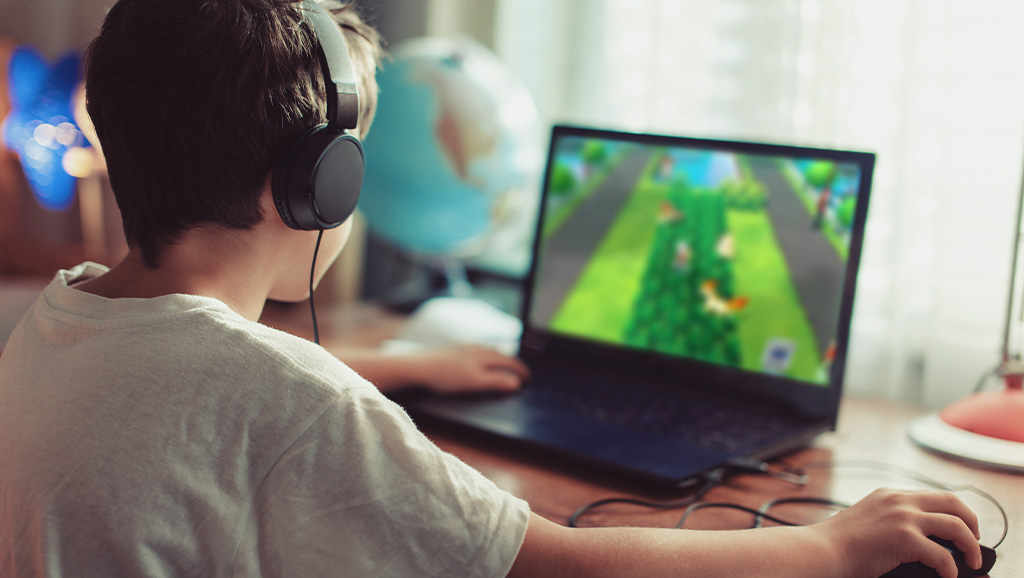At the start of the school year, it seems parents can count on two things to dominate their social media feeds: back-to-school photos and a variety of viral articles about kids’ use of smartphones, tablets, and video games. While the first day photos are welcome, the screen time articles are often quite alarming.
Many contend that screen time is contributing to childhood obesity, depression, anxiety, and anti-social and unfocused behavior. They say that screen use is robbing this generation of kids of their full potential—and their childhoods. They liken screens to “digital heroin,” with the ability to turn your formerly sweet six-year-old into a “psychotic junkie.” They ask whether screen time is dangerous and how to put the brakes on its use. They share worries that such negative effects have become even more perilous, since so many children participated in virtual schooling during the Covid-19 pandemic. These articles may discuss different aspects of screen time, but they share the same panicked tone and suggest that the very nature of digital screens disrupts the course of normal childhood brain development.
But can these writers say that screens are disrupting normal brain development with any degree of certainty? Despite the dozens of articles on the dangers of screen time to the developing brain—and the corresponding counter pieces that suggest screens aren’t the devils they’re made out to be—there is a dearth of research regarding the effects of media use on the brain.
Even with that lack of empirical evidence, the conversation regarding the matter is severely biased, says Jenny Radesky, a pediatrician at the University of Michigan who consults with the American Academy of Pediatrics (AAP) on childhood screen use and helped to develop the organization’s latest set of screen use guidelines.
“This is an increasingly judgmental discourse among parents—being a low-tech or a high-tech parent and how it affects your children,” she says. “So much of what people are talking about does more to induce parental guilt, it seems, than to break down what the research can tell us about screen use—and that’s a real problem.”
A Congressional Briefing on Social Media
At a September 2023 Back-to-School briefing given by the Congressional Neuroscience Caucus (CNC), scientists from the Adolescent Brain Cognitive Development (ABCD) study, the largest longitudinal research study examining the different factors influencing brain development, discussed what their results had to say about screen time. The study, which is following approximately 12,000 children starting at the age of 9-10 throughout adolescence, assessed screen time, defined as any activities including texting, video gaming, streaming, and social media, through self-report measures, as well as objective recordings of how much time was spent on specific applications.
Elizabeth Hoffman, the Senior Scientific Program Manager of the ABCD study, noted correlations between those who used screens more often and a small increase in sleep problems, lower grades in school, and a lower number of friends. There was also an association with attention-deficit/hyperactivity disorder (ADHD) symptoms. On the positive side, the researchers also found video gaming to be associated with increased problem-solving skills, flexible thinking, and recall of facts and skills. But Hoffman emphasized, as she shared the results, that correlation is not causality.
“These data are showing patterns and links with screen use and mental health and cognition outcomes,” she said. “It’s a really nuanced set of findings. It’s not all good news or bad news. It’s a mix. And it’s dependent on not just how much time folks are spending on screens, but what they’re doing on screens.”
The Challenges of Studying Screen Time
One of the biggest challenges involved with understanding the impact of screen time on the brain is that it is difficult to design a balanced, controlled study to investigate the matter. Many studies, like the ABCD study, rely largely on self-reported surveys, says Radesky, and while they may associate screen time with a particular outcome or behavior, they cannot establish firm causality.
“You see some huge data sets where researchers say that kids who watched more television when they were two were more likely to develop attention-deficit/hyperactivity disorder when they are seven,” she says. “But it’s too blunt a tool. Even if you try to statistically adjust for other factors like poverty, or family stress, or parenting style, you can’t get rid of all the possible confounds. What we need are more studies that examine stress and parenting style as moderators—meaning, testing whether media use affects children differently in different contexts.”
Robert Desimone, a neuroscientist who studies attention at the Massachusetts Institute of Technology, agrees. He says the same thing is true of neuroimaging studies.
“The majority of studies looking at media effects are correlational. They look at the brain structure in kids who spend more time playing computer games than other kids,” he says. “Because of that, it’s always a bit of a chicken-and-egg problem. Is it that kids whose brains are a little bit different are more attracted to playing these games? Or are games causing these differences in the brain? There’s no equivalent of a controlled clinical trial, where you take a group of kids and randomly assign them to play computer games or not. I’m not sure you could even ethically do that. So, distinguishing cause and effect is extremely difficult.”
While researchers have successfully performed controlled experiments using music and reading interventions to investigate brain changes, computer games can be more difficult to get institutional review boards (IRBs) to sign off on. Even if they can get approval, researchers still must convince the parents to permit their children to participate.
“Parents are worried about how their kids spend time on entertainment. They have always been worried about this,” says DeSimone. “We know that music education and reading can be beneficial to general learning. So, parents are willing to let their kids be randomly assigned to a piano or a reading group. But chances are, they aren’t going to be so willing to allow their kids to be assigned to a Minecraft group. It’s a huge practical problem.”
A second practical problem is just what constitutes “screen time” itself. The cognitive resources required to watch television versus play a first-person shooter game on PlayStation 3 are quite different, for one; and every day, virtual technologies are becoming more vivid, involving more senses and offering more interactivity for users. That makes the concept of “screen time” difficult to properly define and makes it difficult for researchers to design studies that keep up with the latest technology.
“The research world is so far behind what these different devices and apps can do. It’s difficult to do the studies to even figure out what’s best for kids before the technologies change again,” says Heather Kirkorkian, director of the Cognitive Development and Media Lab at the University of Wisconsin.
Individual differences in kids are an additional, important issue. Some kids are simply drawn to devices more than others—and different kids like to engage with different activities while using them. Parents often hear that excessive screen use can lead to internet or gaming addictions. But Douglas Gentile, a developmental psychologist from Iowa State University who has studied media use for the bulk of his career, says those outcomes are fairly rare.
“Issues of addiction are potentially a very serious concern, but they aren’t all that common,” he says. “There are immense individual differences in how kids respond to different media. And we’d need to have thousands of kids in a single study—which might yield hundreds with an addiction—to track the etiology of the problem, how long it lasts, what types of outcomes it may yield, how it may be coordinated with other problems, and how best to treat it.”
Neuroplasticity, Screen Time, and the Brain
While there is strong evidence to suggest that blue light screens can interfere with sleep and circadian rhythms in both adults and children, other studies are open to interpretation. Several studies, in fact, show what could be described as positive changes in the brain in response to certain types of media use. Simone Kühn, a neuroscientist at Germany’s Max Planck Institute for Human Development and University Clinic Hamburg, for example, has completed several studies looking at video game playing and the brain. She found that compared to infrequent game players, individuals who play video games to the tune of nine hours per week, show larger volumes in areas of the brain such as the nucleus accumbens, linked to reward processing, as well as cortical thickness in the prefrontal cortex, the seat of executive control.
“My expectation was that we’d find detrimental effects of video game playing. But I clearly found the opposite,” she says. “It is difficult to say whether this is only a positive thing because these are correlational studies, and we need intervention studies to prove any causal effects.”
When she and her colleagues completed an intervention study, she found that non-gamer adults who played Super Mario Brothers about 30 minutes a day over a two-month period showed increased gray matter volume in the hippocampus, prefrontal cortex, and cerebellum, as well as improvement in spatial navigation skills. She believes her work offers the possibility that video games or other digital applications could be used to help with issues regarding attention and spatial navigation—and perhaps even neuropsychiatric disorders.
Other studies have found what are considered negative effects, including reductions in gray matter, but Abigail Baird, a Vassar neuroscientist who studies the teen brain, says that we can’t be sure they are actually harmful.
“We can’t say with any certainty that new technology is bad for brains. The only thing we can really say is that it’s a new experience for brains,” she explains. “Because of what we have come to understand about neuroplasticity, we now know that most experiences make changes to the brain—and that includes technology. But I don’t know that we’re even close to understanding whether that’s a good thing or a bad thing, or maybe even just a neutral thing.”
Yet, Jan-Marino Ramirez, a neuroscientist at Seattle Children’s Hospital whose work was highlighted in a popular NPR piece about how heavy screen time can “rewire” the brain,” says that we still don’t understand the long-term consequences of these brain changes—and it’s something that the neuroscience community should be tackling empirically.
“We know that enrichment is good for the brain. But some of these devices and games are overwhelming—there’s so much information, and it goes so fast. When we give mice this kind of stimulation, they have no balance in adjusting their attention, and they become very impulsive,” he says. “We don’t know if that is true in humans. But we need to understand whether there may be a situation where we are doing too much to the brain—if there is a limit to the amount of information our brain can process—and what that might do to alter brain development.”
What Neuroscience Can Tell Us About Screen Time
We now understand that screen time, like any other new experience, can make changes to the brain. But what do the studies tell us about some of our biggest concerns regarding kids and device use?
Many of the viral articles that vilify screen use say that technology is eroding children’s ability to pay attention, and they highlight the potential link between heavy screen use and attention disorders such as ADHD. Michael Posner, a pioneer in the field of cognitive neuroscience from the University of Oregon, says that screens themselves are not causing attention problems. Rather, it’s likely the way they are used.
“There are multiple brain networks involved in attention, and they change quite a bit in early development. Screens could have effects on the span of attention, especially if you are constantly switching from one thing to another, but it’s all a manner of how the device is used,” he explains. “There’s also evidence that different computer games or activities can actually help with attention.”
The real concern when it comes to attention appears to be multitasking. And Desimone, who studies the effects of “information overload” on attentional states, agrees.
“Whether you are talking about screens or any other aspect in life, normally, people do much better when they try to concentrate on one task instead of trying to do two things at once. Similarly, there is a cost to switching back and forth between tasks—enough of a cost that it’s not worth the effort to try and do so. We’ve known that for a long, long time,” he explains.
“Kids trying to do their homework while watching television is nothing new. Now, maybe they’re trying to do it while they are checking their tablet or phone. The answer to dealing with that is the same as it was 30 years ago—while you can try to use your attentional system to filter out the distracting information, it’s 100 times better, not to mention a lot easier, to just physically turn off the distracting device and focus on the task at hand.”
What about emotion? Is this “digital heroin” turning kids, toddlers, and teens into “psychotic junkies” who can’t control their emotions? When such screen time articles are posted on social media sites, you will often see parents commenting that their kids are moodier after engaging with devices and become angry when they are asked to unplug. But Baird is circumspect.
“I remember reading Vanity Fair as a teen. I’d be engrossed in some great story, and my mom would want my attention. I was very irritable about being interrupted,” she says. “But being irritated because what you are doing is very interesting and you don’t want to stop doing it is very different than ‘I can’t regulate my emotion or attention.’ I think we need to be careful about the kinds of conclusions we draw from anecdotes.”
Ellen Selkie, a pediatrician who specializes in teens at the University of Michigan, says that many people emphasize that teens’ stress and mental health problems have risen in the past few years—right as children and teens have adopted more smartphones and tablets. But, she cautions, we don’t have good scientific proof that these two situations are related.
“Whether these changes are due to screen time, well, we can’t really tell that from a research standpoint,” she explains. “We do not have any sort of comparison group that has not been exposed to screens. This concept of teens being ‘emotionally stunted’ is nothing new. With every advance in technology that affects teens, we say that it is eroding future generations. The irony is that the people saying this now are the ones who were supposedly being ‘warped’ by television just a few decades ago.”
A Matter of Context and Content
With the brain developing over the course of 20+ years—and still so much to learn about “normal” development—determining empirically-validated guidelines about screen use is a tough task. In the wake of studies that show digital applications can, in some circumstances, help with the very things critics claim they are destroying, Baird says it is important to keep an open mind.
“History tells us that agenda-driven science isn’t good science.” she says. “It’s important to remember that screens are a tool. Think of a hammer. Yes, you could murder someone with a hammer, but most people don’t. They use it to build and create and fix. There isn’t enough good science to tell us when, or even if, technology as a tool is going to be a problem yet.”
Radesky agrees. While she says there is still much to learn about the impact of devices on the brain, it’s becoming clearer that considering the context and content of screen use is key to finding a healthy, happy medium. In her line of work, she says, you see just how differently kids are “wired.” As such, there can’t be a simple one-size-fits-all approach. The 2020 AAP guidelines try to reflect that.
“We know the way that children develop best is through play, social interactions, unstructured curiosity, and structured family routines. We also know that there are some risks involved with heavy media use,” she says. “But just as it’s not appropriate to act as if no limits need to be placed, it’s not appropriate to say that all kids should have only 30 minutes of screen time per day and that’s it. There are so many different factors in play here—and each family needs to think proactively about the limits they want to set based on their children and their family.”
The AAP suggests that inappropriate, sexual, or violent content should be avoided, as should excessive use. Parents, Radesky says, should have a media plan specific to their family and stick to it. But, she cautions, it’s also important for parents to model the behaviors they would like their kids to use when it comes to device use. There’s no point in telling your kids to get off their iPads if you can’t bother to put your own device down at the dinner table, she says.
Gentile agrees that setting limits is important. And he has some empirical evidence from a longitudinal study to back that up.
“Parents are in a more powerful position than they realize. We did a study with more than 1,400 families in two states and found that parents who set limits on the amount and content of children’s media make a significant difference in terms of kids getting more sleep, doing better in school, being more pro-social, being less aggressive, and being at lower risk for obesity. This was pretty surprising because these are very different types of variables, and parents had different ways of setting those limits. Yet we still saw a strong effect,” he says. “Simply setting limits on children’s media… has this huge ripple effect across a wide range of positive health indicators, even though parents won’t be able to see the effects easily.”
*The original version of this article was published on November 6, 2017, and has been updated.




